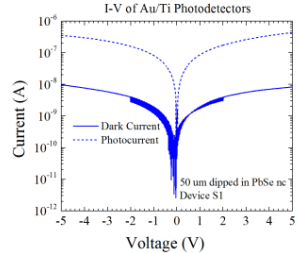Creation of Infrared Photodetectors Utilizing Colloidal Nanostructures
Student: Justin Hill
Degree: M.S., December 2016
Major Professor: Dr. Omar Manasreh
Research Area(s):
Physical & Chemical Sensors
Nanoscience & Engineering
Background/Relevance
- Current infrared photodetectors are limited by the materials with which they are made.
- Bulk PbSe has a band gap that is well below the visible spectrum.
Innovation
- By forming quantum structures out of PbSe, it is possible to obtain band gaps for a large range of energies in the near infrared.
Approach
- Synthesize quantum dots using lead and selenium precursor solutions, then surround quantum dots with ligands.
- Exchange ligands for shorter, less resistive hydrocarbons.
- Deposit dispersed but highly concentrated quantum dots onto photodetectors with varying channel widths.
- Test for I-V enhancement between dark current and photocurrent.

Key Results
- Able to produce highly responsive PbSe quantum dots with little size variation.
- Currently working on optimization of PbSe/PbS core/shell synthesis.
- Increased chemical yield with usage of catalyst during synthesis procedure.

Future Work
- Optimization of precursor concentrations, reaction time, and temperature for core/shell synthesis.
- Application of quantum dots to photodetectors with varying channel widths.
- Try differing sizes of quantum dots and measure differences in current-voltage characteristics.
